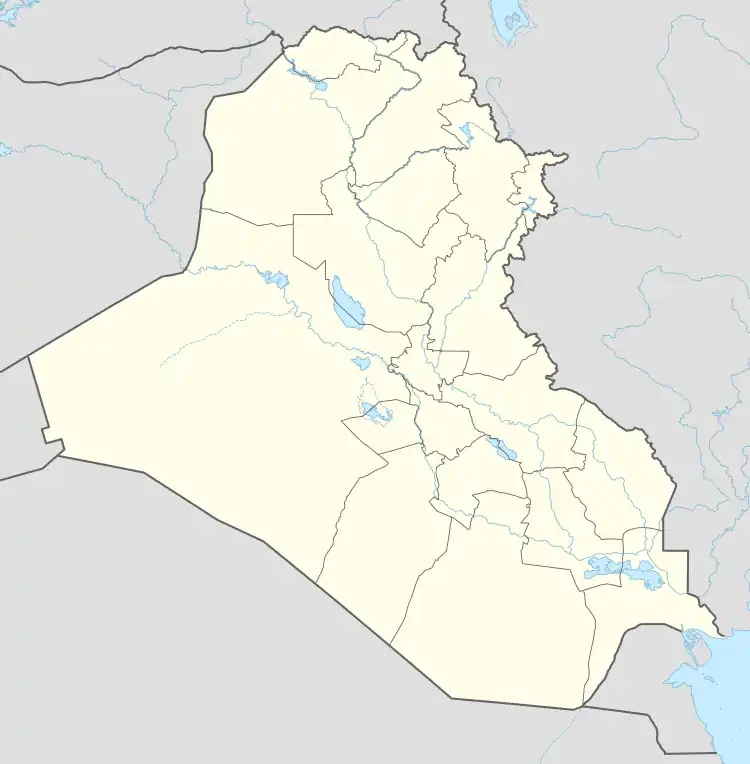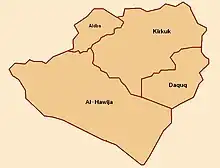Hawija | |
|---|---|
 Hawija Hawija's location in Iraq | |
| Coordinates: 35°19′30″N 43°46′20″E / 35.32500°N 43.77222°E | |
| Country | |
| Governorate | Kirkuk Governorate |
| District | Al-Hawija District |
| Elevation | 190 m (620 ft) |
| Population (October 2017) | |
| • Total | ± 200,000 |
| Time zone | UTC+3 (AST) |
Hawija (Arabic: الحويجة, Al-Ḥawīja)[1] is the central town of Al-Hawija District in the Kirkuk Province of Iraq, 45 km (28 mi) west of Kirkuk, and north of Baghdad. The town has a population of about 100,000 inhabitants.
Hawija District has approximately 150,000 inhabitants, mostly populated by Sunni Arabs.[2]

History
Hawija, also called Hawija Al-Ubaid, is inhabited by Al-Ubaid tribe, Dulaim tribe, Al Jubour, Shammar tribes.
Iraq War 2003-11
During the Iraq War, U.S. and Iraqi forces experienced numerous lethal attacks in the area from Sunni insurgents. The area of Hawija was once considered one of the most dangerous in all of Iraq with US soldiers and the foreign press corps in Baghdad dubbing Hawija "Anbar of the North," a reference to the violence wracked province in Western Iraq.[3]
After U.S. withdrawal
According to open sources on 23 April 2013, Hawija became the focus of violent anti-government protest and deadly Government intervention tactics which left at least 27 Sunnis protesters shot dead, exacerbating political division and sectarian polarization within Iraq.[4][5][6] Later death toll of protests was 53, while associated violence resulted in 215 deaths by April 27. This crackdown prompted Sunni tribal figures in the town and across northern Iraq to harden their rhetoric against Maliki's government. Gun battles erupted across Iraq's majority-Sunni cities between protesters and Iraqi Security Forces—including in Ramadi, Fallujah, and Mosul. From Jordan, influential religious figure Sheikh Abdul Malik al-Saadi said, "self defense has become a legitimate and legal duty." Some Sunni tribes mobilized, declaring jihad against Baghdad.[7][8]
An ISIL operated prison was raided in the area by Kurdish and American special forces on October 21, 2015. After about 70 prisoners were freed, the US bombed the facility.[9]
During ISIL occupation, Hawija's residents have suffered severe shortages of critical supplies, including food, water, and medicine. Many of the town's residents have fled. The Kurdistan Regional Government estimates that 18,000 people fled Hawija in August 2016; they say that approximately 400–450 families arrive at Peshmerga checkpoints from Hawija each week. The UN estimates about 300 arrivals at the Debaga Refugee Camp (one of the largest in Iraq) each week. Unconfirmed reports indicated that ISIL is executing civilians caught trying to escape, and planting land mines to keep residents in place.[7][10]
Hawija, along with Mosul, is a place where ISIS members frequently carry out mass executions. For example, on August 6, 2016, they were said to have executed at least 100 people.[11][12]
ISIL-occupied Hawija became isolated from the rest of ISIL's territory in July 2016 during the Battle of Mosul, when Al-Shirqat was captured by Iraqi troops. Hawija was ISIL's last enclave in central Iraq.[13]
On September 21, 2017, Iraqi Prime Minister Haider al-Abadi announced an offensive to reclaim the city after over three years of ISIS rule.[14] The city was liberated from ISIS by October 4, 2017.[15]
In October 2022, Khadija Ahmad Murshid, also known as "Umm Rayyan", was chosen as the Mukhtar of the Al-Hurriyya neighborhood in Hawija, making her the first woman recorded to hold the position of Mukhtar in the Kirkuk Province.[16][17]
References
- ↑ "الحويجة.. مدينة عراقية بقبضة تنظيم الدولة". Al-Jazeera. Retrieved 10 October 2020.
- ↑ "Iraq: What is the strategic importance of Hawija?". Al-Jazeera. Retrieved 10 October 2020.
- ↑ "Battle to remove ISIL from Hawija could unlock further sectarian tensions".
- ↑ "Iraqi Sunni protest clashes in Hawija leave many dead". BBC News. 23 April 2013.
- ↑ Parker, Ned (23 April 2013). "Iraq violence sparks fears of a Sunni revolt". Retrieved 18 April 2018 – via LA Times.
- ↑ "Iraq’s bloody election: Polls and protests". The Economist. 27 April 2013.
- 1 2 "Forgotten Front Line in Hawija - EPIC". 2016-09-30. Retrieved 2016-10-03.
- ↑ Arango, Tim (2013-04-23). "Clashes at Sunni Protest Site in Iraq Kill Dozens". The New York Times. ISSN 0362-4331. Retrieved 2016-10-03.
- ↑ Jethro Mullen; Melissa Gray (25 October 2015). "New video shows scenes of hostage rescue in Iraq". cnn.com. Retrieved 18 April 2018.
- ↑ "Iraqi Government Still Silent on Hawija Humanitarian Crisis [EN/AR]". 2016-09-19. Retrieved 2016-10-03.
- ↑ Abdallah, Amir (6 August 2016). "ISIS kills 85 civilians in Hawija". Iraqi News. Retrieved 2016-09-28.
- ↑ Abdallah, Amir (4 August 2016). "ISIS executes 12 civilians, holds over 3000 hostage". Iraqi News.
- ↑ "Almost everybody is against a Kurdish referendum". The Economist. 16 September 2017. Retrieved 16 September 2017.
- ↑ "Iraqi forces launch offensive to retake Hawija from IS". BBC. 21 September 2017. Retrieved 21 September 2017.
- ↑ "Hours after entering the city, Popular Mobilization Units (PMUs) announce the capture of Hawija, one of ISIS's last strongholds in Iraq - Today news from war on ISIS in English from Somalia, Egypt, Afghanistan, Iraq, Syria - Deir ez-Zur operation - isis.liveuamap.com". Today news from war on ISIS in English from Somalia, Egypt, Afghanistan, Iraq, Syria - Deir ez-Zur operation - isis.liveuamap.com. Retrieved 18 April 2018.
- ↑ "العراق.. اختيار امرأة لأول مرة لتشغل منصب المختار في محتفظة كركوك". Alhurra. 21 October 2022. Retrieved 3 December 2022.
- ↑ "First woman Mukhtar (Head of the town) in Kirkuk". The Global Coalition Against Daesh. 28 November 2022. Retrieved 3 December 2022.